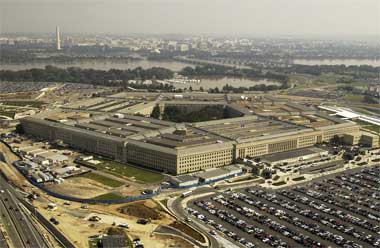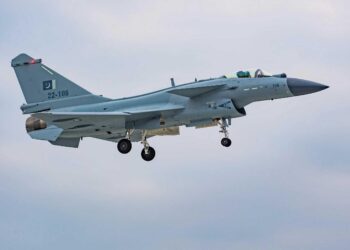A recently completed defense acquisition program report, which is now before Congress, is part of a data-driven effort to find out what’s working best in equipping the nation’s military and to fix what isn’t, the Pentagon’s undersecretary of acquisition, technology and logistics said in an interview with American Forces Press Service.
Frank Kendall said the report, the first in what’s expected to become a series of annual reviews, evaluated major programs across the department. The study is a step toward mastering the mountain of data military acquisition generates.
“Even our best performers have room for improvement,” the undersecretary said. “Figuring out what to do to improve, I think, is the next question.”
Kendall often references the large, engraved wooden sign outside his office door bearing a quote from the late American statistician and professor W. Edwards Deming: “In God we trust; all others must bring data.”
“I’m a firm believer that improvements to policies and processes must be driven by data and objective analysis rather than conjecture and opinion,” Kendall said, adding the report “begins to share [that] kind of objective analysis.”
Kendall said an institutional-level view of defense acquisition — a field that includes research and development, testing and evaluation, fielding and maintenance of virtually all U.S. military equipment — is important because “our processes tend to come from our institutional cultures and norms.”
Acquisition underlies all military operations, he noted, adding, “If you’re serving out there and you’re waiting for the next generation of whatever piece of equipment, this is the system that’s producing that for you. … There are a lot of very hard-working people in government and industry trying to do that.”
The point of the report, Kendall said, “is to help us all figure out ways to do a better job with [acquisition]” and ultimately to ensure more and better products.
The report doesn’t make judgments or excuses, he noted.
“I want each institution to look at how well they are performing compared to others and ask themselves how they learn from one another to improve performance,” he added.
Kendall said the report shows that, in some measures, program and organizational performance across the department has improved, but more progress is needed.
“Very recent data show statistically significant improvement, but only time and further analysis will tell if these trends continue into the future,” he said. “For example, comparing the last two decades, the Army and Air Force have reduced total cost growth on contracts, and the Army has reduced contract costs-over-target. The Air Force also has lowered contract schedule growth.”
Kendall said despite such trends, “The magnitude of absolute performance issues leaves considerable room for additional improvement. Due to the nature of pushing the state-of-the-art in weapon systems, we will never have zero cost and schedule growth. But, we can certainly do better and have recent indications that this is possible.”
One major finding from the report is that “a lot of the things we thought were important may not be as important as we believed,” he said. “Fixed-price versus cost-plus contracting, for example.”
Fixed-price contracts are let at a set price for the work, while cost-plus contracts reimburse the contractor’s expenses and also add other funds, which can include award, incentive and performance fees.
Statistics for the two kinds of contracts were more similar than he expected, Kendall said. He added he’s never thought fixed-price contracts were “a panacea,” and while conventional wisdom is that fixed pricing solves a lot of problems, “I don’t think that’s the case, and the data shows that.”
Unsurprisingly, the review found that undefinitized contracts show the highest cost growth, the undersecretary said. The department can use these types of contracts to meet urgent needs, as they authorize contractors to begin work before contract terms are set.
“We tend to over-run our development programs … by about 30 percent,” Kendall said. “We tend to over-run our production programs by about 10 percent. So there’s a lot more variability and uncertainty and risk on the development side of the house.”
If the buyer hasn’t defined requirements or projected costs, he said, “You’re going to start a lot of people doing a lot of work that they’re not really ready to do, and that leads to huge inefficiencies. … The data shows that very strongly.”
Kendall added that the data also surprised him by showing that “undefinitized contract actions do not generally correlate with total cost growth on early procurement contracts. We found that it is a factor in development, but we were worried that the effect was also statistically measurable in procurement but is, in fact, not.”
Kendall said he wants to do more work on understanding which factors matter and how they correlate, but that all analysis to date points to the importance of good management.
“It wasn’t a surprise to me,” the undersecretary said. “I’ve been emphasizing the professionalism of the acquisition workforce … it’s been a constant theme of mine.”
Any project benefits from better management, Kendall noted. “We could avoid a lot of our disasters, and we could do much better in the margins in all of our programs, the better we are at managing programs and making sound decisions,” he added.
Examining factors in cost growth always leads to “a whole host of additional questions you have to ask,” Kendall said. Future reports will examine more and different defense acquisition data and institutions, both government and industry, he noted.
“It will also expand on the analysis,” he said. “I’m very open to ideas about how we get at understanding what’s really going on in the acquisition system.”
Two key take-aways from the report, Kendall said, are first, that the United States has a decisive strategic edge in its military, which is the best in the world; and second, that “the fact that it may cost us too much and take us too long to get there shouldn’t be neglected, either.”
Kendall said he had expected many of the report’s findings.
“We knew that cost growth has been high and that the recent wars have placed a premium on technical performance and schedule at the expense of cost growth,” he said. “The report reinforces the importance of our Better Buying Power initiative that [Deputy Defense Secretary Ash Carter] and I began in 2010 and I have continued to expand.”
Kendall told reporters during a Pentagon briefing in May that Better Buying Power 2.0 is a step forward in “a very, very complicated business.”
Kendall said Better Buying Power 2.0 covers a wide range of products and services that defense acquisition requires. There were 23 initiatives in Better Buying Power 1.0, 34 in 2.0 and “another 100 things, at least, that we’re working on,” he said during that briefing.
This new report, Kendall said, offers an analytic basis for further action. “For example, the finding that fixed-price contracts are not a ‘magic bullet’ to controlling cost has reinforced my experience that we need to consider and select the most appropriate contract type given the maturity, system type and business strategy for each system,” he said.
The report’s findings should help “reinvigorate cost consciousness in our culture,” Kendall said.
“This is especially important now that we are winding down the wars and have such intense fiscal constraints on the department,” he said. “We all must weigh not just the benefits of a particular capability, but also its benefits given the cost to the taxpayers.”
[Download not found]











